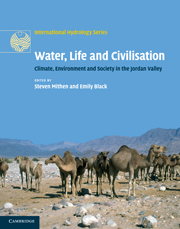Book contents
- Frontmatter
- Contents
- List of figures
- List of tables
- List of contributors
- Acknowledgements
- 1 Introduction: an interdisciplinary approach to Water, Life and Civilisation
- Part I Past, present and future climate
- Part II The palaeoenvironmental record
- Part III Hydrological studies of the Jordan Valley
- 10 The impacts of climate change on rainfall-runoff in the upper River Jordan: methodology and first projections
- 11 Modelling Dead Sea levels and rainfall: past, present and future
- 12 The hydrology of the Wadi Faynan
- 13 Future projections of water availability in a semi-arid region of the eastern Mediterranean: a case study of Wadi Hasa, Jordan
- Part IV Human settlement, climate change, hydrology and water management
- Part V Palaeoeconomies and developing archaeological methodologies
- Part VI Society, economy and water today
- Part VII Conclusions
- Index
- Plate section
- References
13 - Future projections of water availability in a semi-arid region of the eastern Mediterranean: a case study of Wadi Hasa, Jordan
from Part III - Hydrological studies of the Jordan Valley
Published online by Cambridge University Press: 26 April 2011
- Frontmatter
- Contents
- List of figures
- List of tables
- List of contributors
- Acknowledgements
- 1 Introduction: an interdisciplinary approach to Water, Life and Civilisation
- Part I Past, present and future climate
- Part II The palaeoenvironmental record
- Part III Hydrological studies of the Jordan Valley
- 10 The impacts of climate change on rainfall-runoff in the upper River Jordan: methodology and first projections
- 11 Modelling Dead Sea levels and rainfall: past, present and future
- 12 The hydrology of the Wadi Faynan
- 13 Future projections of water availability in a semi-arid region of the eastern Mediterranean: a case study of Wadi Hasa, Jordan
- Part IV Human settlement, climate change, hydrology and water management
- Part V Palaeoeconomies and developing archaeological methodologies
- Part VI Society, economy and water today
- Part VII Conclusions
- Index
- Plate section
- References
Summary
ABSTRACT
This chapter is concerned with a model-based assessment of the effects of projected climate change on water security in the rural west of Jordan. The study area is the Wadi Hasa, a large (2,520 km2) catchment which drains from the Jordanian plateau to the Dead Sea at Ghor Safi. The Wadi Hasa is regionally important in terms of both water resources and archaeology. A substantial database was collated to describe the hydrological functioning of the catchment and a new monthly time-step hydrological model, HYSIMM, was developed and applied within a modelling framework, which also includes the HadRM3 regional climate model and a weather generator, to provide future projections of mean monthly flows. Under the A2 storyline, the climate in the region of Wadi Hasa in 2071–2100 was projected to become drier, with a mean annual precipitation 25% less than the present day, and warmer; winter and summer temperatures were projected to increase by approximately 4 and 6 degrees centigrade, respectively. Spatial differences in the projected precipitation depths and temperatures are apparent across the region. The modelled outcomes suggest that the mean monthly flows will decrease in winter because of the reduced precipitation, and the modelled flows were more sensitive to changes in precipitation than potential evapotranspiration. Overall, the monthly flood flows are predicted to decrease by 22% and the base flow by 7% by the end of the century under the A2 storyline. […]
- Type
- Chapter
- Information
- Water, Life and CivilisationClimate, Environment and Society in the Jordan Valley, pp. 175 - 188Publisher: Cambridge University PressPrint publication year: 2011

